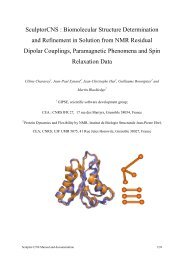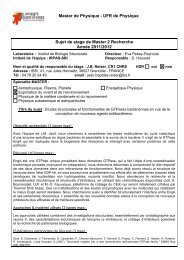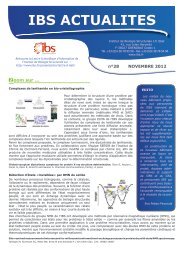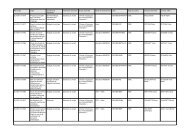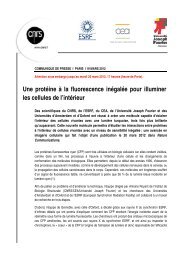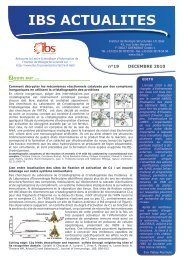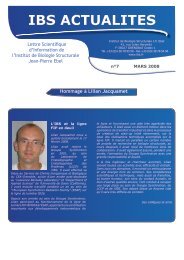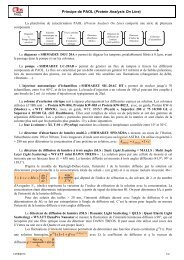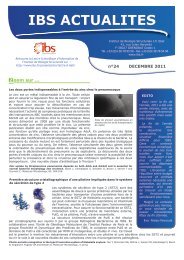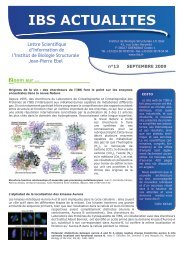n°25 - Institut de Biologie Structurale
n°25 - Institut de Biologie Structurale
n°25 - Institut de Biologie Structurale
You also want an ePaper? Increase the reach of your titles
YUMPU automatically turns print PDFs into web optimized ePapers that Google loves.
IBS ACTUALITES<br />
Retrouvez la Lettre Scientifique d’Information <strong>de</strong><br />
l’<strong>Institut</strong> <strong>de</strong> <strong>Biologie</strong> <strong>Structurale</strong> sur :<br />
http://www.ibs.fr/presentation/lettre-d-info/<br />
<strong>Institut</strong> <strong>de</strong> <strong>Biologie</strong> <strong>Structurale</strong> J.P. Ebel<br />
41, rue Jules Horowitz<br />
F-38027 GRENOBLE Ce<strong>de</strong>x 1<br />
Tél. +33 (0)4 38 78 95 50 - Fax +33 (0)4 38 78 54 94<br />
www.ibs.fr<br />
n°25 FEVRIER 2012<br />
Z oom sur ...<br />
Un pepti<strong>de</strong> pour mimer un sucre et inhiber l’entrée du VIH dans les cellules<br />
L’entrée du VIH dans les cellules repose sur l’interaction <strong>de</strong> la<br />
protéine virale gp120 avec le récepteur CD4 et les GPCR CCR5<br />
ou CXCR4. Cette double interaction représente donc une cible<br />
pharmacologique d’intérêt dans <strong>de</strong>s stratégies visant à inhiber<br />
l’entrée du virus.<br />
Dans cette perspective, le groupe SAGAG <strong>de</strong> l’IBS a solubilisé<br />
CCR5 et CXCR4 par un cocktail <strong>de</strong> lipi<strong>de</strong>s et <strong>de</strong> détergents,<br />
permettant <strong>de</strong> conserver leurs fonctions <strong>de</strong> reconnaissance, et<br />
effectué <strong>de</strong>s mesures d’interactions par SPR entre gp120 et ces<br />
récepteurs.<br />
Par ailleurs, <strong>de</strong>s travaux précé<strong>de</strong>nts avaient montré que les<br />
héparanes sulfate (HS) se liaient à gp120 et interféraient<br />
avec l’entrée virale. La complexité <strong>de</strong>s HS ne permettant pas<br />
d’i<strong>de</strong>ntifier aisément les déterminants moléculaires impliqués<br />
dans l’interaction, <strong>de</strong>s pepti<strong>de</strong>s contenant <strong>de</strong>s sulfotyrosines (dont le nombre et la position<br />
peuvent être facilement modifiés) et mimant ces polysacchari<strong>de</strong>s ont été générés.<br />
En combinant ces <strong>de</strong>ux aspects (mesure d’interaction gp120/GPCR et génération <strong>de</strong><br />
mimétiques d’oligosacchari<strong>de</strong>s), une molécule, appelée mCD4-P3YSO3, a été développée,<br />
en collaboration avec l’<strong>Institut</strong> Pasteur et l’Université d’Orsay. Cette molécule inhibe<br />
l’interaction <strong>de</strong> gp120 avec CD4, CCR5 ou CXCR4 et bloque la réplication d’isolats<br />
cliniques du VIH avec <strong>de</strong>s IC50 <strong>de</strong> 0,5 nM. Ces résultats positionnent ce composé <strong>de</strong><br />
manière favorable pour le développement d’un inhibiteur du VIH.<br />
A synthetic heparan sulfate-mimetic pepti<strong>de</strong> conjugated to a mini CD4 displays veryhigh anti-HIV-1<br />
activity in<strong>de</strong>pen<strong>de</strong>ntly of coreceptor usage. Connell B.J., Baleux F., Coic YM., Clayette P., Bonnaffé D and<br />
Lortat-Jacob H. Chemistry and Biology, 19: 131-139<br />
Expression <strong>de</strong> protéines membranaires en système Cell free<br />
Les difficultés rencontrées lors <strong>de</strong>s étu<strong>de</strong>s structurales <strong>de</strong> protéines membranaires<br />
commencent dès leur expression. Le système <strong>de</strong> production acellulaire est par conséquent<br />
très attractif car il <strong>de</strong>vrait contourner certaines difficultés (insertion dans la membrane,<br />
toxicité <strong>de</strong>s protéines membranaires surexprimées). Néanmoins, pour assurer le bon<br />
repliement <strong>de</strong>s protéines membranaires, il faut rajouter au milieu <strong>de</strong> réaction <strong>de</strong>s<br />
molécules amphiphiles capables <strong>de</strong> se complexer aux protéines afin <strong>de</strong> masquer leur<br />
surface hydrophobe.<br />
Nous avons exploré l’expression d’UCP1, une protéine membranaire <strong>de</strong> la famille <strong>de</strong>s<br />
transporteurs mitochondriaux en présence <strong>de</strong> différents surfactants. L’utilisation <strong>de</strong><br />
surfactants fluorés a permis d’obtenir <strong>de</strong>s quantités <strong>de</strong> protéines pures compatibles avec<br />
la cristallisation. Le spectre CD d’UCP1 ainsi produite, est comparable au spectre <strong>de</strong> la<br />
protéine extraite <strong>de</strong> tissus naturels.<br />
Ce travail, réalisé par le groupe Membrane <strong>de</strong> l’IBS, a fait l’objet d’une collaboration<br />
avec une équipe <strong>de</strong> chimistes <strong>de</strong> l’université d’Avignon pour la synthèse <strong>de</strong> nouveaux<br />
surfactants, et avec une équipe <strong>de</strong> l’IBPC Paris, pour les étu<strong>de</strong>s fonctionnelles d’UCP1.<br />
C’est ainsi la 2ème protéine membranaire produite dans le système in vitro dans l’équipe.<br />
L’expertise acquise, ainsi que la production <strong>de</strong>s extraits cellulaires, sont maintenant à la<br />
disposition <strong>de</strong>s utilisateurs <strong>de</strong> la plate-forme « cell free ».<br />
EDITO<br />
La liste <strong>de</strong>s travaux<br />
présentés dans ce numéro<br />
(entrée du virus<br />
HIV, expression <strong>de</strong><br />
transporteurs membranaires,<br />
complexes d’organismes<br />
extrêmophiles,<br />
division cellulaire<br />
et différentes méthodologies),<br />
reflète encore<br />
une fois la force <strong>de</strong>s<br />
cinq axes thématiques<br />
<strong>de</strong> l’IBS. Cette visibilité<br />
scientifique nous a<br />
permis d’être présents<br />
dans les projets Investissements<br />
d’Avenir,<br />
FRISBI et GRAL,<br />
qui sont maintenant en<br />
marche.<br />
Malgré le froid <strong>de</strong>s<br />
<strong>de</strong>rnières semaines, il<br />
ne manque plus qu’un<br />
seul étage au nouveau<br />
bâtiment IBS et nous<br />
pouvons déjà imaginer<br />
son allure et sa taille.<br />
Avec 31 projets,<br />
l’IBS a été à nouveau<br />
très actif dans le dépôt<br />
<strong>de</strong>s projets ANR Blanc,<br />
soit en moyenne 1 projet<br />
pour 2 chercheurs.<br />
Souhaitons que ces<br />
projets rencontreront<br />
le succès mérité.<br />
Eva Pebay-Peyroula<br />
Production of UCP1 a membrane protein from the inner mitochondrial membrane using the cell free expression system in the presence of<br />
a fluorinated surfactant. Blesneac I, Ravaud S, Juillan-Binard C, Barret LA, Zoonens M, Polidori A, Miroux B, Pucci B, Pebay-Peyroula E. Biochimica et<br />
Biophysica Acta (BBA) - Biomembranes;1818(3):798-805
IBS Actualités<br />
n°25 - février 2012<br />
A xes thématiques<br />
Axe «Nouvelles approches pour la biologie<br />
structurale intégrée»<br />
La réunion annuelle du Club <strong>de</strong>s utilisateurs du Biacore en<br />
Rhône-Alpes, organisée par N. Thielens et I. Bally <strong>de</strong> la plateforme<br />
SPR, s’est déroulée à l’IBS le 11 janvier 2012 aprèsmidi.<br />
Six utilisateurs lyonnais et grenoblois ont présenté<br />
leurs travaux <strong>de</strong>vant une trentaine <strong>de</strong> participants, issus<br />
<strong>de</strong> laboratoires académiques et industriels <strong>de</strong> la région.<br />
La réunion s’est terminée par une discussion informelle<br />
portant sur différents aspects techniques <strong>de</strong> l’utilisation<br />
du Biacore. La prochaine réunion aura lieu dans un an à<br />
l’IBCP <strong>de</strong> Lyon.<br />
D ernières publications<br />
A diglucosylated fluorinated surfactant to handle<br />
integral membrane proteins in aqueous solution.<br />
Abla M, Durand G, Breyton C, Raynal S, Ebel C and Pucci<br />
B. Journal of Fluorine Chemistry, 134: 63-71<br />
A glycomimetic compound inhibits DC-SIGNmediated<br />
HIV infection in cellular and cervical<br />
explant mo<strong>de</strong>ls. Berzi A, Reina JJ, Ottria R, Sutkeviciute<br />
I, Antonazzo P, Sanchez-Navarro M, Chabrol E, Biasin M,<br />
Trabattoni D, Cetin I, Rojo J, Fieschi F, Bernardi A and<br />
Clerici M. AIDS, 26: 127-137<br />
A supplementary coil for (2)H <strong>de</strong>coupling with<br />
commercial HCN MAS probes. Huber M, With O,<br />
Schanda P, Verel R, Ernst M and Meier BH. Journal of<br />
Magnetic Resonance, 214: 76-80<br />
Charged multivesicular body protein 2B (CHMP2B)<br />
of the endosomal sorting complex required for<br />
transport-III (ESCRT-III) polymerizes into helical<br />
structures <strong>de</strong>forming the plasma membrane. Bodon<br />
G, Chassefeyre R, Pernet-Gallay K, Martinelli N, Effantin G,<br />
Hulsik DL, Belly A, Goldberg Y, Chatellard-Causse C, Blot<br />
B, Schoehn G, Weissenhorn W and Sadoul R. Journal of<br />
Biological Chemistry, 286: 40276-40286<br />
Cryo-electron microscopy of ribosomal complexes in<br />
cotranslational folding, targeting, and translocation.<br />
Knoops K, Schoehn G and Schaffitzel C. Wiley<br />
Interdisciplinary Reviews RNA, in press<br />
Density contrast sedimentation velocity for the<br />
<strong>de</strong>termination of protein partial-specific volumes.<br />
Brown PH, Balbo A, Zhao H, Ebel C and Schuck P. PLoS<br />
ONE, 6: e26221<br />
Effects of hydrostatic pressure on the quaternary<br />
structure and enzymatic activity of a large peptidase<br />
complex from Pyrococcus horikoshii. Rosenbaum E,<br />
Gabel F, Durá MA, Finet S, Cléry-Barraud C, Masson P and<br />
Franzetti B. Archives of Biochemistry and Biophysics, 517:<br />
104–110<br />
Fast protein backbone NMR resonance assignment<br />
using the BATCH strategy. Brutscher B and Lescop E.<br />
Methods in Molecular Biology, 831: 407-428<br />
Generation and biological properties of a recombinant<br />
do<strong>de</strong>cahedron containing the short fiber protein of<br />
the human a<strong>de</strong>novirus 41. Siqueira-Silva J, Fenel D, Gout<br />
E, Yeda FP, Marinheiro JC, Barrella KM, Silva ML, Schoehn<br />
G, Harsi CM and Fen<strong>de</strong>r P. Intervirology, in press<br />
High hydrostatic pressure equipment for neutron<br />
scattering studies of samples in solution. Peters J,<br />
Trapp M, Hughes D, Rowe S, Demé B, Laborier JL, Payre<br />
C, Gonzales JP, Baudoin S, Belkhier N and Lelièvre-Berna<br />
E. High Pressure Research, in press<br />
iHADAMAC: a complementary tool for sequential<br />
resonance assignment of globular and highly<br />
disor<strong>de</strong>red proteins. Feuerstein S, Plevin MJ, Willbold<br />
D and Brutscher B. Journal of Magnetic Resonance, 214:<br />
329-334<br />
Isolation and analysis of cell wall components from<br />
Streptococcus pneumoniae. Bui NK, Eberhardt A, Vollmer<br />
D, Kern T, Bougault C, Tomasz A, Simorre J-P and Vollmer<br />
W. Analytical Biochemistry, in press<br />
Lipid nanoparticule vectorization of IndoCyanine<br />
Green improves fluorescence imaging for tumor<br />
diagnosis and lymph no<strong>de</strong> resection. Navarro FP, Berger<br />
M, Guillermet S, Josserand V, Guyon L, Neumann E, Coll<br />
JLR, P. and Texier I. Journal of Biomedical Nanotechnology,<br />
in press<br />
M-ficolin and leukosialin (CD43): new partners<br />
in neutrophil adhesion. Moreno-Amaral AN, Gout E,<br />
Danella-Polli C, Tabarin F, Lesavre P, Pereira-da-Silva<br />
G, Thielens NM and Halbwachs-Mecarelli L. Journal of<br />
Leukocyte Biology, in press<br />
Mutational dissection of the S/T-kinase StkP<br />
reveals crucial roles in cell division of Streptococcus<br />
pneumoniae. Fleurie A, Cluzel C, Guiral S, Freton C,<br />
Galisson F, Zanella-Cleon I, Di Guilmi AM and Grangeasse<br />
C. Molecular Microbiology, in press<br />
Oligomerization paths of the nucleoprotein of<br />
influenza A virus. Tarus B, Bakowiez O, Chenavas S,<br />
Duchemin L, Estrozi LF, Bourdieu C, Lejal N, Bernard J,<br />
Moudjou M, Chevalier C, Delmas B, Ruigrok RW, Di Primo<br />
C and Slama-Schwok A. Biochimie, in press
IBS Actualités<br />
n°25 - février 2012<br />
Stress regulation of the PAN-proteasome system<br />
in the extreme halophilic archaeon Halobacterium.<br />
Chamieh H, Marty V, Guetta D, Perollier A and Franzetti B.<br />
Extremophiles, in press<br />
Studies on the parameters controlling the stability<br />
of the TET peptidase superstructure from Pyrococcus<br />
horikoshii revealed a crucial role of pH and catalytic<br />
metals in the oligomerization process. Rosenbaum<br />
E, Ferruit M, Durá MA and Franzetti B. Biochimica et<br />
Biophysica Acta (BBA) - Proteins & Proteomics, 1814:<br />
1289-1294<br />
The C-terminal polyproline-containing region of<br />
ELMO contributes to an increase in the life-time<br />
of the ELMO-DOCK complex. Sévajol M, Reiser J-B,<br />
Chouquet A, Pérard J, Ayala I, Gans P, Kleman J-P and<br />
Housset D. Biochimie, in press<br />
The human C1q globular domain: structure and<br />
recognition of non-immune self ligands. Gaboriaud<br />
C, Frachet P, Thielens N and Arlaud GJ. Frontiers, in<br />
Immunology, in press<br />
The role of nanometer-scaled ligand patterns in<br />
polyvalent binding by large mannan-binding lectin<br />
oligomers. Gjelstrup LC, Kaspersen JD, Behrens MA,<br />
Pe<strong>de</strong>rsen JS, Thiel S, Kingshott P, Oliveira CL, Thielens NM<br />
and Vorup-Jensen T. Journal of Immunology, 188: 1292-<br />
1306<br />
R encontres scientifiques<br />
• 15eme conférence du Groupe d’Etu<strong>de</strong>s <strong>de</strong>s<br />
Membranes, 2 au 4 avril 2012, Paris : le GEM, un sousgroupe<br />
thématique <strong>de</strong> la Société Française <strong>de</strong> Biophysique,<br />
organise un congrès sur les <strong>de</strong>rniers développements en<br />
matière <strong>de</strong> protéines membranaires, que ce soit d’un point<br />
<strong>de</strong> vue physique, chimique ou biologique. L’inscription et<br />
la soumission d’abstract est possible sur http://gem15.<br />
fr/, ou auprès <strong>de</strong> F. Fieschi (IBS/MP), membre du comité<br />
scientifique <strong>de</strong> ce congrés.<br />
• Atelier «Détermination <strong>de</strong> la Structure <strong>de</strong>s<br />
protéines par RMN», 21 au 25 Mai 2012, IBS : le<br />
groupe <strong>de</strong> RMN biomoléculaire <strong>de</strong> l’IBS et le Laboratoire<br />
<strong>de</strong> Chimie et <strong>de</strong> <strong>Biologie</strong> <strong>Structurale</strong>s <strong>de</strong> l’ICSN organisent<br />
une formation pratique avancée <strong>de</strong>stinée à fournir aux<br />
participants les outils nécessaires à l’étu<strong>de</strong> structurale <strong>de</strong>s<br />
protéines par RMN du liqui<strong>de</strong>. Inscription avant le 20 avril<br />
(nombre <strong>de</strong> places limité à 18).<br />
• XXVe Conférence internationale sur la résonance<br />
magnétique dans les systèmes biologiques, 19 au<br />
24 aout 2012, Lyon : cette conférence vise à faire le<br />
point sur les nouveaux développements et les applications<br />
biologiques impliquant la RMN en solution, la RMN du<br />
soli<strong>de</strong>, la résonance paramagnétique électronique, la<br />
RMN in vivo, la métabolomique et l’IRM. M. Blackledge<br />
(IBS / FDP) est membre du comité scientifique <strong>de</strong> cette<br />
conférence, considérée comme l’un <strong>de</strong>s congrès majeurs<br />
dans le domaine <strong>de</strong> la résonance magnétique en biologie.<br />
Pour plus <strong>de</strong> détails sur ces événements, consulter<br />
http://www.ibs.fr/seminaires-et-evenements/congres-etateliers/<br />
N ouvelle plate-forme<br />
La plateforme Cell Free est maintenant ouverte aux<br />
utilisateurs. Elle s’appuie sur l’expertise <strong>de</strong>s groupes<br />
transporteurs membranaires, membrane & pathogenes<br />
et RMN biomoleculaire pour la production gran<strong>de</strong> échelle<br />
par synthèse in vitro d’ARN et <strong>de</strong> protéines solubles<br />
ou membranaires (cf zoom). La plateforme propose<br />
notamment la mise à disposition <strong>de</strong> tests <strong>de</strong> criblage et <strong>de</strong><br />
faisabilité, <strong>de</strong> protocoles <strong>de</strong> production optimisés et d’une<br />
paillasse en environnement RNAse Free pour former et<br />
accueillir les utilisateurs.<br />
Le formulaire <strong>de</strong> <strong>de</strong>man<strong>de</strong><br />
d’étu<strong>de</strong> est disponible en<br />
ligne sur www.ibs.fr, à<br />
la page <strong>de</strong> la plateforme<br />
Cell Free. Contact: lionel.<br />
imbert@ibs.fr.<br />
P rix et distinctions<br />
T.Vernet vient d’être nommé membre du conseil scientifique du département «Microbiologie et chaîne alimentaire<br />
(MICA) <strong>de</strong> l’INRA pour la pério<strong>de</strong> 2011 - 2015.
IBS Actualités<br />
n°25 - février 2012<br />
N ouveaux arrivants<br />
Nous souhaitons bonne chance à Jacques JOLY qui a rejoint<br />
l’INSA <strong>de</strong> Villeurbanne en mai, ainsi qu’à Laurence SERRE<br />
qui a rejoint Grenoble <strong>Institut</strong> <strong>de</strong>s Neurosciences début<br />
janvier.<br />
• Yoann SALLAZ-DAMAZ a été embauché dans le<br />
groupe GSY en tant qu’ingénieur <strong>de</strong> recherche CNRS, en<br />
remplacement <strong>de</strong> Jacques Joly. Il aura en charge l’étu<strong>de</strong>, la<br />
conception et la mise en oeuvre <strong>de</strong> solutions informatiques<br />
dans le domaine <strong>de</strong> l’instrumentation scientifique sur la<br />
ligne <strong>de</strong> lumière FIP,<br />
• Paul GUERRY a été recruté comme chercheur pour un<br />
CDD <strong>de</strong> 2 ans dans le groupe FDP. Il travaillera sur le rôle<br />
<strong>de</strong> la dynamique conformationelle dans la promiscuité <strong>de</strong> la<br />
protéine Ubiquitine, et la caracterisation <strong>de</strong>s mouvements<br />
lents dans la reconnaissance entre Ubiquitine et ses<br />
partenaires cellulaires,<br />
• Ekaterina ROUND a été recrutée comme chercheuse<br />
pour un CDD d’un an dans le groupe MEMBRANE.<br />
Elle travaillera sur le développement <strong>de</strong> métho<strong>de</strong>s<br />
<strong>de</strong> cristallisation in meso à haut débit <strong>de</strong> protéines<br />
membranaires, la cristallisation et étu<strong>de</strong>s structurales du<br />
transporteur glutamate,<br />
• Ombeline PESSEY a été recrutée pour un CDD d’un an<br />
en tant qu’assistante ingénieur dans le groupe IRPAS . Elle<br />
travaillera sous la direction <strong>de</strong> D. Housset sur la production<br />
et la cristallisation <strong>de</strong> complexes TCR-pepti<strong>de</strong>-CMH,<br />
• Guillaume TOURCIER a été embauché en tant que<br />
technicien dans le groupe Pneumocoque pour un CDD d’un<br />
an. Il travaillera à la valorisation d’un brevet,<br />
• Hubert MAYERHOFER démarrer un post-doc <strong>de</strong> 8<br />
mois dans le groupe Membrane, sous la direction <strong>de</strong> S.<br />
Ravaud. Il étudiera <strong>de</strong>s transporteurs membranaires <strong>de</strong><br />
nucléoti<strong>de</strong>s,<br />
• Yann FICHOU et Gianluca SANTONI démarrent une<br />
thèse dans le groupe DYNAMOP sous la direction <strong>de</strong> <strong>de</strong><br />
Martin Weik. Yann étudiera le rôle <strong>de</strong> l’eau en biophysique<br />
macromoléculaire et Gianluca explorera la dynamique<br />
structurale <strong>de</strong> l’acetylcholinesterase,<br />
• Laurène MARCHAND et Yann HUON DE KERMADEC<br />
ont démarré une thèse dans le groupe MEMBRANE en<br />
octobre 2011 sous la direction d’E. Pebay-Peyroula.<br />
Laurène Marchand étudiera le transporteur ATP/ADP <strong>de</strong>s<br />
chloroplastes. Yann, co-encadré par D. Willbold <strong>de</strong> FZJ<br />
Julich (dans le cadre <strong>de</strong> l’accord entre IBS et ce centre<br />
<strong>de</strong> recherche), s’intéressera à l’utilisation <strong>de</strong>s nanodisques<br />
pour intégrer les protéines membranaires et conduire à<br />
leur caractérisation,<br />
• Marina IANNELLO a été recrutée pour un CDD <strong>de</strong> 6 mois<br />
en tant qu’assistant ingénieur dans le groupe IRPAS. Elle<br />
travaillera à la production et la cristallisation <strong>de</strong> fragments<br />
<strong>de</strong> calréticuline <strong>de</strong> Trypanosoma cruzi, sous la direction <strong>de</strong><br />
C. Gaboriaud.<br />
S outenances <strong>de</strong> thèses<br />
• le 01/02 à 14h, Malene Ringkjøbing Jensen (IBS/FDP)<br />
a soutenu son HDR, intitulée ”Characterising disor<strong>de</strong>red<br />
proteins using nuclear magnetic resonance spectroscopy :<br />
Recent <strong>de</strong>velopments and future perspectives”,<br />
• le 28/02 à 14h, Shahid Mehmood (IBS/M&P)<br />
soutiendra sa thèse, intitulée ”Structural characterization<br />
of membrane proteins by hydrogen/<strong>de</strong>uterium exchange<br />
mass spectrometry”,<br />
• le 16/03 à 14h, Bridgette Janine Connell (IBS/SAGAG)<br />
soutiendra sa thèse, intitulée ”Development of a binding<br />
assay between the HIV-1 envelope protein (gp120) and<br />
coreceptors CCR5/CXCR4 by surface plasmon resonance:<br />
screening and optimization of viral entry inhibitors”,<br />
• le 20/03 à 14h, Eve <strong>de</strong> Rosny (IBS/Metallo) soutiendra<br />
son HDR, intitulée ”Etu<strong>de</strong>s structurales et mécanistiques<br />
<strong>de</strong> protéines impliquées dans le déclenchement <strong>de</strong><br />
processus biologiques».<br />
Directeur <strong>de</strong> la publication<br />
Comité <strong>de</strong> rédaction<br />
Correspondants <strong>de</strong> groupes<br />
E. Pebay-Peyroula<br />
J. Boisbouvier, G. Eminet, E. Forest, J.M. Jault, O. Kaïkati, J. Neyton, JL. Parouty<br />
M. Blackledge, J. Boisbouvier, A. Dessen, J.L. Ferrer, F. Fieschi, J. Fontecilla,<br />
B. Franzetti, H. Lortat-Jacob, E. Neumann, J. Peters, C. Petosa, A. Remeeva,<br />
N. Thielens, T. Vernet, M. Vivaudou<br />
Contributeurs aux Zooms <strong>de</strong> février : H. Lortat-Jacob & E. Pebay-Peyroula



